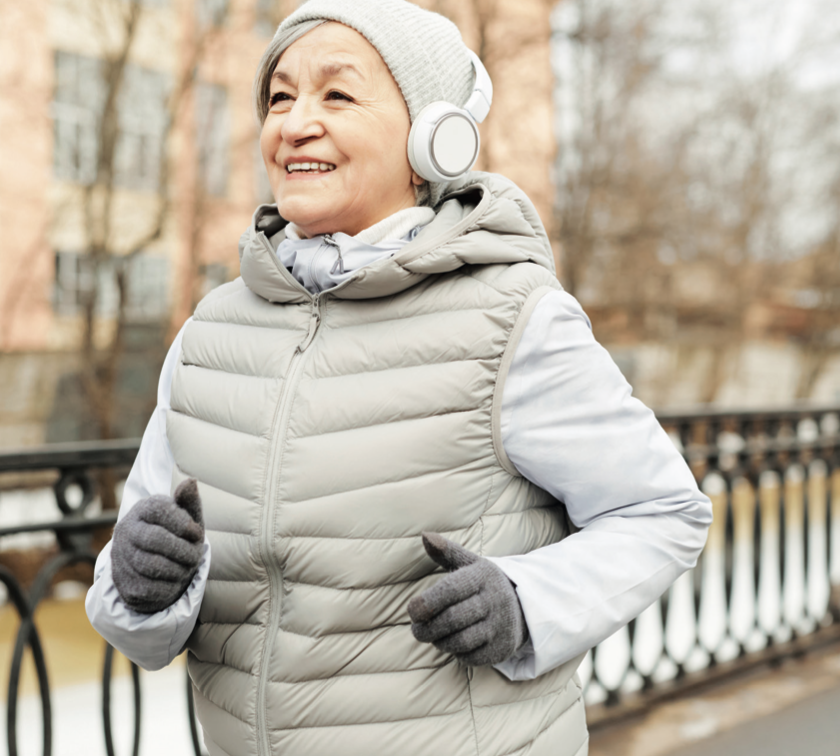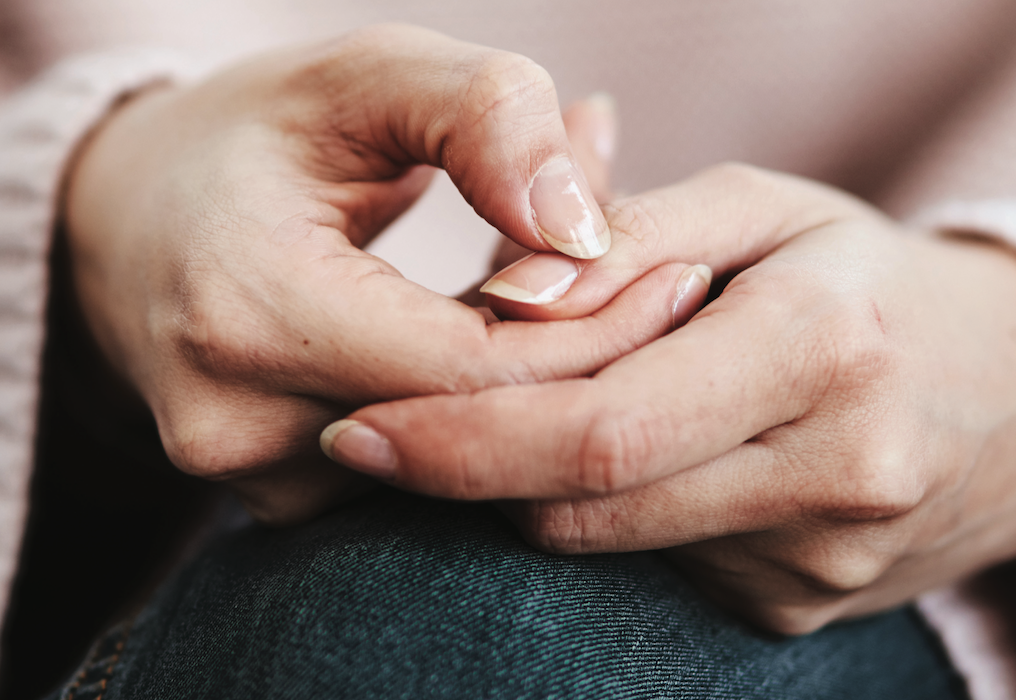Gaining some control over the symptoms can greatly improve your quality of life
By Wendy Haaf
When Jenny Hauser was diagnosed with moderate to severe osteoarthritis (OA) in both knees at age 50, the London, Ont., yoga instructor was handed a prescription for naproxen and told to lose some weight and book an appointment for an in-office procedure that could provide short-term pain relief. “They wanted to do steroid injections right away,” Hauser recalls. Apart from an explanation of how modest weight loss could improve her pain by easing stress on her joints, Hauser was given next to no information about her disease or how to manage it. The unspoken message seemed to be that nothing more could be done unless or until the disease progressed to the point at which she would need a total knee replacement.
However, while we don’t yet have medications that can alter the course of this most common form of arthritis, there are a number of strategies that can help people reduce their pain and improve their quality of life.
OA affects an estimated one in seven Canadians. In a healthy joint, the ends of the bones are protected by a tough yet spongy tissue called cartilage and surrounded by fluid. Cartilage allows the bones in the joint to slide smoothly with movement. In OA, this cushioning material starts getting eaten away. The process seems to be related to the release of proteins that can cause the tissue that lines the joint to become inflamed. That the release of these proteins can increase after an injury to the joint, such as a ligament tear, may at least partially explain why such injuries are linked with an increased risk for developing OA in the affected joint later on. In other words, contrary to what experts once believed, the primary culprit behind damage to the cartilage isn’t normal wear and tear, says Dr. Janet Pope, a rheumatologist at St. Joseph’s Health Care London and a professor of medicine at Western University’s Schulich School of Medicine & Dentistry, both in London, Ont..
The symptoms, including specific patterns of pain and stiffness, help confirm the presence of the disease. “Usually, it’s diagnosed with a history and a physical and doesn’t need blood tests, X-rays, or other imaging,” Pope says. Most people don’t need to see an orthopaedic surgeon. Exceptions include people with night pain, severe pain, and very impaired mobility.
What can someone with OA do to manage pain and maintain as much mobility as possible in the affected joint? Often, the answer is not one type of treatment alone but a combination.
Weight Management
For OA of the hip and particularly of the knee, Pope says, “if people are overweight, even mild weight loss can be helpful.” While wear and tear doesn’t cause OA, excess weight puts added strain on the joint, which can worsen pain. For people with knee or hip OA who weigh more than is considered healthy, weight management is a first-line treatment.
Exercise and Education
If you were going to do only one thing for your OA, exercise would be your best choice. For one thing, it does the opposite of wearing away cartilage. Because cartilage has no blood supply, it relies on the surrounding fluid to provide nutrients and dispose of waste products. In the knee, for instance, stepping onto a surface squeezes out depleted fluid and waste, and when you lift your leg, the cartilage absorbs a fresh batch. And, in a sense, cartilage is similar to muscle in that it requires stimulation via exercise to remain robust.
“When you don’t move, cartilage actually becomes more brittle,” explains Marlee Shloush, a physiotherapist with The Arthritis Society in Toronto. “The most important thing for people with OA to hear is that staying physically active is going to give them the best chance at extending the life of their joint,” says Dr. Tom Appleton, site chief of rheumatology at St. Joseph’s Health Care London.
In a trial in which people who were eligible for knee replacement were randomly assigned to either receive immediate surgery or a 12-week education and exercise program with the option to proceed to surgery afterwards if they chose, 74 per cent of the latter group hadn’t gone ahead with an operation one year after completing the program.
There’s another reason exercise is the most effective treatment for OA. Over time, regular exercise will decrease pain levels and help maintain flexibility and range of motion. “If someone stops moving, they’re going to get stiffer, their muscles get weaker, and the result is more pain,” Shloush says. Conversely, strengthening the surrounding muscles lessens the load on a weight-bearing joint like the knee.
A physiotherapist can help you come up with a plan that’s tailored to you. “People with arthritis need to find exercise that can be lifelong,” Shloush says. “It’s finding an exercise that you enjoy, that’s manageable with your lifestyle, and that doesn’t aggravate your pain too much.” Walking, cycling, swimming, tai chi and even seated exercises can all be good options. You can find some instructional exercise videos on The Arthritis Society’s website: arthritis.ca.
At first, and in the short-term, your pain will probably get worse during exercise, but pain doesn’t equate to damage. How much pain is okay? There are a couple of principles to keep in mind. Number one: “If you think of pain on a zero-to-10 scale, generally pain between zero and five during exercise is considered acceptable, as long as it goes back to your pre-exercise level within 24 hours or so,” Shloush says. “If it doesn’t, either you need to change how you’re doing the activity, with either less effort or less time, or choose something different.”
Finding what works for you may take some trial and error. That’s what Susan Larkin, who now volunteers with The Arthritis Society in Toronto, found after being diagnosed with hip OA at 62. Until not so long before that, “I went to Zumba three times a week, plus Pilates and walking,” she says. That quickly deteriorated, however, “until I literally could not even walk around the block,” she says. Eventually, Larkin tried a warm-water exercise class, continuing the program on her own afterwards. “I went almost daily to get me going in the morning because mornings are always the worst,” she says. “That sort of set me up for the day.”
Other Non-Drug Measures
Another reason to consult a physiotherapist if possible is that these health professionals can determine whether you have a joint misalignment that could be improved with devices such as a customized shoe insert or might benefit from other aids, such as canes, Nordic walking poles, splints, or braces. For example, if the OA is affecting only one of the knee’s three compartments, “a brace called an unloader can take the stress off of that specific compartment,” Shloush says. Some people find that applying heat or cold to the affected joint during a pain flare-up or after activity can offer some relief as well. “When people ask, I say try one, and if that doesn’t help, try the other,” Pope says.
Topical Products
For smaller joints, such as those in the fingers, and even for single larger joints (apart from the hip), topical medications containing a non-steroidal anti-inflammatory drug (NSAID) in the same family as ibuprofen (Advil) may be worth trying. The brand name of the product that’s available over the counter in Canada is Voltaren, which contains diclofenac. (It comes in two different strengths.) A slightly more potent prescription liquid, known as Pennsaid, contains topical diclofenac and can be used for knee OA.
“There are a few benefits with a topical product,” says Naomi Steenhof, an assistant professor in the University of Toronto’s Leslie Dan Faculty of Pharmacy and a pharmacotherapy specialist at the University Health Network. “You can apply it right where it hurts, up to four times a day.” And because it’s absorbed through the skin, only a tiny amount of the drug gets into the bloodstream. This means “you’re able to bypass a lot of the negative effects NSAIDs can have when taken orally,” she says. (More on those in the next section.)
While less likely to provide pain relief than those containing NSAIDs, topical products with capsaicin, the chemical that gives chilies their burn, can sometimes mitigate OA pain by blocking pain messages to the nerves.
Oral OTC Medications
Like topical products and heat and cold therapy, over-the-counter pain medications can be tools that help you stay active.
It’s a good idea to check with your pharmacist before you start taking over-the-counter pain pills, particularly if you have other chronic health issues or take other medications. “For some people, depending on their medical conditions, one of these medications may have quite severe consequences,” Steenhof says.
“Most guidelines recommend trying acetaminophen [Tylenol] first, because it doesn’t have a lot of side effects [or potential drug interactions],” she notes. (It can potentially cause liver problems when combined with large amounts of alcohol. Consequently, Steenhof recommends limiting your total daily acetaminophen intake to 2,000 mg if you consume two standard drinks per day, and if you drink more than that, avoid it or consult a liver specialist.)
A much more common pitfall is under-dosing. “A 325 mg tablet one or two times a day is probably not going to help,” Steenhof explains. “If someone’s physician or rheumatologist has diagnosed them with arthritis and says try Tylenol, I usually recommend trying 650 to 1,000 mg three times a day for a week to see if that’s going to help.” (Since many cough, cold, and flu preparations contain acetaminophen, read labels carefully if you’re already taking it regularly, since such combinations could potentially lead to liver injury.)
If a trial of acetaminophen fails, a non-steroidal anti-inflammatory is often the next go-to. The two main OTC NSAID choices are ibuprofen (Advil and Motrin) and naproxen (Aleve). There are advantages to the latter. It’s more convenient because it lasts longer and you don’t need to take it as frequently. Naproxen also seems to be safer for the heart than other oral NSAIDs, all of which are linked with an increase in cardiovascular events such as heart attack and stroke.
“I always recommend before someone starts taking an NSAID that they speak with their family doctor, nurse practitioner, or pharmacist because so many medications have drug interactions with NSAIDs,” Steenhof says. For example, they can increase the risk of serious bleeding if you’re taking a blood thinner or if you have a history of stroke or stomach ulcers. And since fluid retention is one possible side effect of NSAIDs, they can worsen heart failure, too.
While the strategies we mention likely won’t reduce your pain to zero, “if you think of pain medication as perhaps helping reduce someone’s pain experience by 10 or 20 per cent and add on another 10 or 20 per cent from all of these modalities, then you can get much better quality of life,” Steenhof says. “People taking control over their symptoms can really do more than they think,” Pope adds.
Take Hauser. She never did make an appointment for steroid injections. Instead, she consulted a physiotherapist, switched from power to regular yoga—which she still teaches four times a week in addition to walking and biking—and modified her diet. For example, she cut down on alcohol and inflammatory foods such as sugar and added more that dampen inflammation, such as leafy greens and turmeric in smoothies. During pain flare-ups, she uses Voltaren, another topical product that contains menthol, and occasionally, oral NSAIDs. Nearly a decade after being diagnosed, Hauser had knee X-rays to check for further cartilage damage. The verdict? “There’s been no significant change,” she says.
Resources
Research suggests that many Canadians with osteoarthritis aren’t optimizing their use of guideline-recommended non-surgical treatments. “People tell me it’s tough to get in to see a rheumatologist when you have osteoarthritis,” says Susan Larkin, a volunteer with the Arthritis Line, a free telephone and email information and support service.
Cost is also a factor for many, according to a recent study. “Most of the conservative options are things that come out of people’s own pockets,” notes Gillian Currie, one of the study’s co-authors and an associate director of Health Economics with Dr. Deborah Marshall’s research team at the University of Calgary.
The following organizations may be able to connect you with free or low-cost services in your area:
The Arthritis Line (The Arthritis Society)
1-800-321-1433, press 2
info@arthritis.ca
Osteoarthritis Service Integration System (Vancouver Coastal Health)
oasis.vch.ca
You can also find helpful information and resources at:
Arthritis Research Canada
arthritisresearch.ca
Canadian Arthritis Patient Alliance
arthritispatient.ca
GLA:D Canada
gladcanada.ca
Versus Arthritis
versusarthritis.org
Photo: iStock






